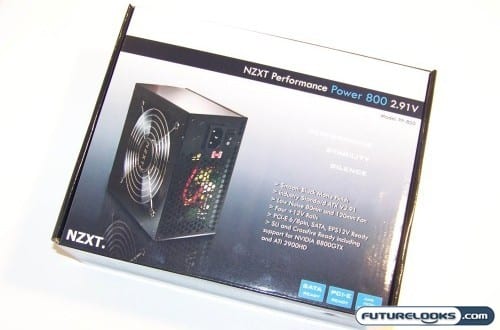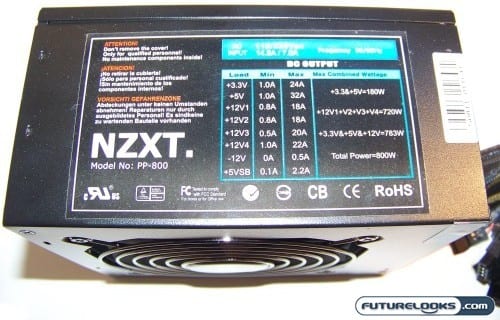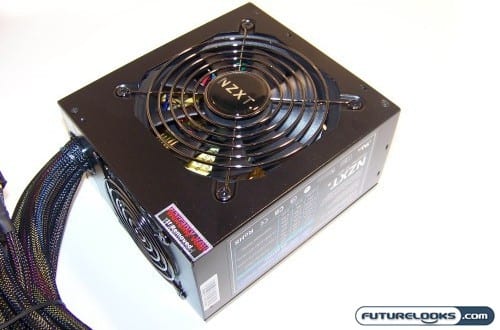
NZXT has positioned themselves as the choice for gamers on a budget. They offer a wide variety of decent cases which can usually be found at the largest national retailers to the smallest retail computer stores. Most of the time, budget gamers will need to purchase their own power supplies as most cases come without one. NZXT has stepped up in this respect by offering quality power supplies at a reasonable price. Today we’ll be looking at NZXT’s Performance Power (PP800) 800 Watt Power Supply.
Features & Specifications
NZXT’s Performance Power series of power supplies offers “performance without sacrifice” and are engineered to provide all the power you need to power most high end systems. The unit offers up a 78% efficiency rating while pushing four +12V rails. The 800 Watts provided should satisfy the needs of most SLI gaming systems.
The Performance Power PP800 also features:
- Compliance with Intel ATX / BTX Standard
- Gold-Coated Connectors
- Output Over / Under / Short / Overload Protection
- Smooth black matte finish
- Industry Standard ATX V2.91
- Low Noise 80mm and 120mm Fan
- Four +12V Rails
- PCI-E 6/8pin, SATA, EPS12V Ready
The features that will attract most users are the quad +12V rails, 78% power efficiency, and both 6 and 8-pin PCIE Express connectors. There’s room to add multiple performance based video cards that need the extra power connectors. The four +12V rails mean plenty of power is spread out among the system. As you can see on the spec label, the +3.3V, +5V, and +12V rails all offer decent respectable amperage.
What’s most significant about the amperage is that NZXT didn’t waste precious amps on the +3.3V and +5V. Quality power supplies will offer a good balance on these two rails where as cheaper ones will offer too much. At 24 and 32 Amps respectively, this is almost the perfect balance. Of course, the +12V1 and +12V2 offer 18 Amps with the +12V3 @ 20 Amps and +12V4 @ 22 Amps.

Another feature not mentioned is the current price. Even though it’s an 800 Watt power supply, it can still be found for $120 to $140 depending on the retailer. This positions it quite aggressively with other proven power supplies. Testing will reveal whether it’s a steal or something too good to be true. NZXT also puts this power supply out in more modest 500 and 600 watt models.
What’s in the Box?
The box contains a power cord, mounting screws, and naturally the power supply. There’s not much to have to bundle inside, though it would have been nice to see a few cheap Velcro straps for managing the cables once the PSU is installed. Moving right along…
Inspecting the Performance Power 800
If the weight is any indication, the Performance Power PP800 is anything but “cheap”. After removing the bubble wrap, you’ll see that the PSU offers a nice gun metal black chassis. However, it’s not entirely solid black as you can see. The overall color should match black computer cases. Going solid black can be a good thing or a bad thing depending on the case used. The finish appears top notch and fully covers every detailed edge. Even the chosen grill matches the theme.
The most obvious thing you’ll notice is that the PSU isn’t modular and is a standard hard wired design. This offers two things in its favor: It saves you some money since modular features can drive up the price and there’s no chance of a questionable connection unless you break a connector. This is where extra velcro straps could have provided some consolation. Otherwise, the cables are wrapped in solid black braiding to keep things looking clean.
Internal cooling is important for performance PSUs as they can create quite a bit of heat while approaching full load wattage. The PP 800 has a front internal clear 80mm exhaust fan as well as a 120mm bottom fan all good for about 82 CFM. If the 80mm were an LED fan, it would have offered a nice effect. I’m sure more adventurous types could make that so quite easily.
Many PSUs don’t offer that additional 80mm fan when a 120mm fan is already prsent. It’s possible this one serves the actual purpose of channeling air directly over the internal heat sinks. It isn’t entirely necessary for it to be there since the 120mm does the bulk of the work driving the warm air out.
Invasive Surgery
After pulling the PSU apart for a quick look, it would appear that the 80mm fan does have a purpose. The internal gold heat sinks can get very hot during extreme loaded conditions and it doesn’t help that they aren’t very large. As long as there’s plenty of air moving, there shouldn’t ever be a problem. The soldered contacts and components look to be attached well and there aren’t any cracked or questionable spots. Even the black and red wires that feed the PSU precious current are quite thick.
Capacitor Size Matters
A PSUs constant power results from two important components: Switches and capacitors. The PP800 has two large 1500 uF 200 V capacitors made by Fuhjyyu. This particular capacitor has had some issues in the past with other PSU brands. However, it was evident that very poor cooling was quite likely the culprit and it’s clear that based on NZXT’s careful design, this is something that is a non issue with this unit.
Considering the amount of cooling here and the capacitor improvements, there shouldn’t be any problems completing the task ahead. If it’s half as good as it appears, perhaps it’ll surprise the cautious skeptic within.
Setting Up The Performance Power 800 For Punishment
Standard operating procedure for basic testing of a power supply entails using a decent test system to validate +3.3V, +5V, and +12V rail performance. The PSU should offer a good, or acceptable level of voltage at idle and system load. Any large voltage fluctuations or drops can cause problems over time if not immediately so.
In order to give the tests some real world relevancy, we assembled a test system using the following components and give a good representation of the mid to high end range of most systems on the market:
- Intel I7 965 Processor
- GIGABYTE GA-EX58-UD3R Ultra Durable 3 Motherboard
- 3x1GB Kingston HyperX DDR3 2000 MHz Triple Channel Memory Kit
- 2 x 500 GB Seagate SATA II Hard Drive
- Zotac GTX 285 1GB AMP Edition Video Card
First, the system was allowed to idle for at least 2 hours. (It gets very boring during this time, so I played a few rounds of BF2 on another system.) At the 2 hour mark, all the rail voltages were checked and recorded.
Next, the system was put under full system load with Prime95, Orthos, and anything else to push the HyperThreaded 8 cores to full load. Again, voltages were measured and recorded. Finally, the PSU was loaded to a 100% of its rated wattage. We did find that the PP800 maxed out at about 815 Watts worth of reliable power which is a bonus compared to its claimed 800 watts.
Voltage Measurements
The results paint a good picture based on the PP800’s performance. Voltages are quite acceptable and voltage fluctuations are kept to a .05 Volt maximum up to about 75% load. The +12V was the only rail to drop below an even 12.00 Volt reading. Granted, it was only at 11.97 Volts which is still within acceptable tolerances for any computer system.
How Efficient is the PP800?
What was the efficiency observed in testing? An efficiency average of 79% was observed up to 60% load. Above this, the PSU was 77% efficient. This measurement was obtained comparing voltage drawn from the wall to wattage produced. All in all, not bad compared to NZXT’s claimed 78% efficiency.
Final Thoughts
The NZXT Performance Power (PP800) 800 Watt Power Supply isn’t quite an 80 Plus club member, but it isn’t very far off. In order to be 80 Plus Certified, it needs to be at least 80+% efficient at 50% load. Often, many power supplies are above this, but don’t subscribe to the standard which isn’t the end of the world. It just means it can be transferred over to cost savings, allowing you to pick up a very efficient power supply at a great price.
The value that the PP800 provides is quite substantial as it can be as much as $40 cheaper than many other 80 Plus Certified units. That’s a lot for those on a budget who are looking for an inexpensive alternative. However, there are a couple other mainstream vendors that offer modular 800 Watt PSU that are quite comparable, though not as aesthetic pleasing as the PP800. Take your pick.
What NZXT has provided in the end is a worthy alternative for people who want to spend what they can afford and get a lot of value in return. This unit withstood very sensitive tests including the dreaded scope and survived. It’s nice to be surprised once in a while. If you have a choice between some no-name, modular cable special or the NZXT Performance Power PP800, go with NZXT. You’ll thank yourself down the road when your system is still running strong.
Pros
- Affordable alternative
- Respectable power performance
- Well balanced Rail amperage
- Quad +12V Rails
- Doesn’t look cheap
- Dual 1200 uF capacitors
- SLI Certified
- Almost 80 Plus without the 80 Plus price
Cons
- No wire management included
- No PSU bundle offered
Overall Rating: 8.0 / 10.0
Discuss this Review in the Futurelooks Community Forums

